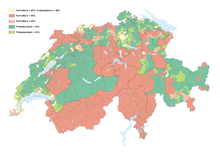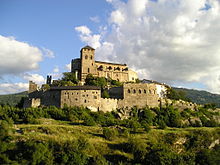- Religion in Switzerland
-
A church in Fischenthal, a village in the canton of Zurich

Switzerland has no country-wide state religion, though most of the cantons (except for Geneva and Neuchâtel) recognize official churches (Landeskirchen), in all cases including the Catholic Church and the Swiss Reformed Church. These churches, and in some cantons also the Old Catholic Church and Jewish congregations, are financed by official taxation of adherents.[1]
Christianity is the predominant religion of Switzerland (91% of total resident population). 5% of the total population are irreligious. The largest minority religion is Islam (4%, figures as of 2000).
Contents
Demographics
As of 2000, about 91% of the Swiss adhered to Christianity; about 5% were irreligious or refused to answer; Islam was the largest minority religion, at about 4%.
The two major religious confessions are the Roman Catholic Church (41.82% of the population) and the Swiss Reformed Church (33.04%). The country is historically about evenly balanced between Catholic and Protestant regions. The larger cities (Bern, Zurich, Basel, Geneva) were and partly still are Protestant, while Central Switzerland and the Ticino are traditionally Catholic. 11.1% of the Swiss were irreligious. Immigration has brought Islam (4.26%) and Eastern Orthodoxy (1.8%) as sizeable minority religions.[2] Other Christian minority communities include Neo-Pietism (0.44%), Pentecostalism (0.28%, mostly incorporated in the Schweizer Pfingstmission), Methodism (0.13%), the New Apostolic Church (0.45%), Jehovah's Witnesses (0.28%), other Protestant denominations (0.20%), the Old Catholic Church (0.18%), other Christian denominations (0.20%). Minor non-Christian minority groups are Hinduism (0.38%), Buddhism (0.29%), Judaism (0.25%) and "other religions" (0.11%). 4.3% did not make a statement.[3]
Regarding personal belief, the 2005 Eurobarometer Poll found that 48% of Swiss citizens expressed belief "that there is a God", 39% expressed belief in "some sort of spirit or life force" while 9% answered that that they did not believe that "there is any sort of spirit, God, or life force"[4]
Legislation
 Minaret at the mosque of the local Turkish cultural association in Wangen bei Olten. Inaugurated in July 2009, after four years of legal and political controversy, this minaret, a Turkey-made plastic construction placed on the roof of the Turkish cultural center, was the initial motivation for the popular initiative voted upon later in 2009 which led to a nation-wide ban of further minarets.[5]
Minaret at the mosque of the local Turkish cultural association in Wangen bei Olten. Inaugurated in July 2009, after four years of legal and political controversy, this minaret, a Turkey-made plastic construction placed on the roof of the Turkish cultural center, was the initial motivation for the popular initiative voted upon later in 2009 which led to a nation-wide ban of further minarets.[5]
The Swiss constitution of 1848, written by the victorious pro-union Protestant cantons after the Catholic-Separatist Civil War of 1847, consciously defines a consociational state, allowing the peaceful co-existence of Catholics and Protestants. However, the Catholic Jesuits (Societas Jesu) were banned from all activities in either clerical or pedagogical functions by Article 51 of the Swiss constitution in 1848. The reason was the perceived threat resulting from Jesuit advocacy of traditionalist Catholicism to the stability of the state. In June 1973, 54.9% of Swiss voters approved removing the ban on the Jesuits (as well as Article 52 which banned monasteries and convents from Switzerland);[6] the vote reflected sharp divisions between the cantons, with 92% of Valais supporting, but 71% of Neuchâtel opposing removing the ban.
The settlement restrictions placed on Swiss Jews in various instances between the 14th and 18th centuries were lifted with the revised Swiss Constitution of 1874.
A popular vote in March 1981 on the complete separation of church and state was clearly opposed to such a change, with only 21.1% voting in support, to the effect of the retention of the Landeskirchen system.[7]
In November 2009, 57.5% of Swiss voters (54% turnout) approved of a popular initiative to ban the construction of minarets in Switzerland. The four existing Swiss minarets, at mosques in Zurich, Geneva, Winterthur and Wangen bei Olten are not affected by the ban.[8]
Freedom of religion
Full freedom of religion has been guaranteed since the revised Swiss Constitution of 1874 (Article 49). During the Old Swiss Confederacy, there had been no de facto freedom of religion, with persecution of Anabaptists in particular well into the 18th century. Swiss Jews had been given full political rights in 1866, although their right to settle freely was implemented as late as 1879 in the canton of Aargau.
The current Swiss Constitution of 1999 makes explicit both positive and negative religious freedom in Article 15, paragraph 3--which asserts that every person has the right to adhere to a religious confession and to attend religious education--and paragraph 4, which asserts that nobody can be forced to either adhere to a religious confession or to attend religious education, thus explicitly asserting the right of apostasy from a previously held religious belief.
The basic right protected by the constitution is that of public confession of adherence to a religious community and the performance of religious cult activities. Article 36 of the constitution introduces a limitation of these rights if they conflict with public interest or if they encroach upon the basic rights of others. Thus, ritual slaughter is prohibited as conflicting with Swiss animal laws. Performance of cultic or missionary activities or religious processions on public ground may be limited. On the other hand, the use of cantonal taxes to support cantonal churches has been ruled legal by the Federal Supreme Court.[9] It is disputed whether the minaret ban introduced in Article 72 of the Swiss Constitution in 2009 constitutes a further limitation of the freedom of religion.[10]
History
Traces of the pre-Christian religions of the area that is now Switzerland include the Bronze Age "fire dogs". The Gaulish Helvetii, who became part of Gallo-Roman culture under the Roman Empire, left only scarce traces of their religion like the statue of dea Artio, a bear goddess, found near Bern. A known Roman sanctuary to Mercury was on a hill north-east of Baar.[11] St. Peter in Zurich was the location of a temple to Jupiter.
The Bishopric of Basel was established in AD 346; the bishopric of Sion, before 381; the bishopric of Geneva. in ca. 400: the bishopric of Vindonissa(now united as the Diocese of Lausanne, Geneva and Fribourg), in 517; and the Diocese of Chur, before 451.
Germanic paganism briefly reached Switzerland with the immigration, from the 6th century, of the Alemanni, who were gradually converted to Christianity during the 6th and 7th centuries, with the establishment of the Bishopric of Constancein ca. 585. The Abbey of St. Gall rose as an important center of learning in the early middle ages.
The Old Swiss Confederacy was Roman Catholic as a matter of course until the Reformation of the 1520s, which resulted in a lasting split of the Confederacy into Protestantism and Catholicism. This split lead to numerous violent outbreaks in Early Modern times and included the partitioning of the former canton of Appenzell into the Protestant canton of Appenzell Ausserrhoden and Catholic Appenzell Innerrhodenin 1597. The secular Helvetic Republic was a brief intermezzo and tensions immediately resurfaced after 1815, leading to the formation of the modern federal state in 1848, which recognizes Landeskirchen on a cantonal basis: the Roman Catholic and the Reformed Churches in each canton, and since the 1870s (following the controversies triggered by the First Vatican Council) the Christian Catholic Church in some cantons.
The Jesuits (Societas Jesu) were the subject of a bitter controversy in 19th century Switzerland. The order had been dissolved in 1773 by Clement XIV, but it was re-instated in 1814 by Pius VII.
Over the following years, the Jesuits returned to the Swiss colleges they had owned prior to 1773, in Brig (1814), Sion (1814), Fribourg (1818) and Lucerne (1845), and especially Fribourg became a center of the Council of Trent. The Protestant cantons felt threatened by the re-appearance of the Jesuits and their program of traditionalist Catholicism, which contributed to religious unrest and the formation of the Sonderbund of the Catholic cantons, and at the Tagsatzung of 1844 in vain demanded the expulsion of the Jesuit order from the territory of the Swiss confederacy. The Protestant victory of the Sonderbundskrieg of 1847 led to the realization of such a ban in the 1848 Swiss Constitution, expanded even further in the revised constitution of 1874, so that all activity of Jesuits either in clerical or in educational function was outlawed in Switzerland until 1973, when the paragraph was removed from the constitution by a popular vote.[12]
Notes
- ^ state.gov - Switzerland
- ^ CIA World Factbook section on Switzerland
- ^ Bovay, Claude; Raphaël Broquet (December 2004), "Introduction" (in French) (pdf), Recensement fédéral de la population 2000, Neuchâtel: Federal Statistical Office, p. 12, ISBN 3-303-16074-0, http://www.bfs.admin.ch/bfs/portal/fr/index/news/publikationen.Document.50517.pdf, retrieved 21 August 2010
- ^ "Eurobarometer on Social Values, Science and technology 2005 - page 11". http://ec.europa.eu/public_opinion/archives/ebs/ebs_225_report_en.pdf. Retrieved 2007-05-05.
- ^ NZZ, 21 July 2009
- ^ http://www.admin.ch/ch/d//pore/va/19730520/can236.html
- ^ Swiss Statistical Office
- ^ Swiss vote to ban construction of minarets on mosques, The Guardian 29 November 2009
- ^ BGE 107 Ia 126, 130
- ^ see Minaret_controversy_in_Switzerland#Individual_legal_experts
- ^ Baarburg at 47°12′18″N 8°33′18″E / 47.205°N 8.555°E; Tages-Anzeiger 5 June 2008 [1]
- ^ Franz Xaver Bischof: Jesuits in German, French and Italian in the online Historical Dictionary of Switzerland. Version of 2008.
See also
- Reformation in Switzerland
- Roman Catholicism in Switzerland
- Islam in Switzerland
- Jews and Judaism in Switzerland
- Buddhism in Switzerland
- Hinduism in Switzerland
- Sikhism in Switzerland
- Demographics of Switzerland
- Religion by country
- Religion in Europe
External links
Religion in Europe Sovereign
states- Albania
- Andorra
- Armenia
- Austria
- Azerbaijan
- Belarus
- Belgium
- Bosnia and Herzegovina
- Bulgaria
- Croatia
- Cyprus
- Czech Republic
- Denmark
- Estonia
- Finland
- France
- Georgia
- Germany
- Greece
- Hungary
- Iceland
- Ireland
- Italy
- Kazakhstan
- Latvia
- Liechtenstein
- Lithuania
- Luxembourg
- Macedonia
- Malta
- Moldova
- Monaco
- Montenegro
- Netherlands
- Norway
- Poland
- Portugal
- Romania
- Russia
- San Marino
- Serbia
- Slovakia
- Slovenia
- Spain
- Sweden
- Switzerland
- Turkey
- Ukraine
- United Kingdom
- (England
- Northern Ireland
- Scotland
- Wales)
States with limited
recognition- Abkhazia
- Kosovo
- Nagorno-Karabakh
- Northern Cyprus
- South Ossetia
- Transnistria
Dependencies
and other territories- Åland
- Faroe Islands
- Gibraltar
- Guernsey
- Jan Mayen
- Jersey
- Isle of Man
- Svalbard
Other entities Categories:- Religion in Switzerland
- Swiss society
- Swiss culture
Wikimedia Foundation. 2010.



